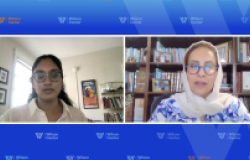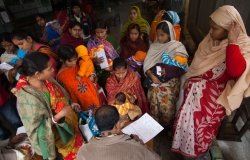Scaling Up Midwives and Traditional Birth Attendants To Reduce Maternal Mortality: Recommendations For Policymakers & Program Managers
With no real progress towards MDG 5 in 15 years, women continue to perish at an alarming rate and one possible solution is to scale-up traditional birth attendants at birth. Experts discuss progress and remaining challenges.
Overview
"We know how to save women's lives, we don't need a cure. This is not a technical problem, this is not an economic problem, this is a political problem, and political will is essential," argued Theresa Shaver, Director of White Ribbon Alliance, on December 17, 2008, at a Woodrow Wilson International Center for Scholars conference. With no real progress towards MDG 5 in 15 years, women continue to perish at an alarming rate and one possible solution is to scale-up traditional birth attendants (TBA's) at birth. Jason B. Smith, Director of Research Utilization of Family Health International, along with his colleagues Theresa Shaver and Dr. Margaret Kruk, Assistant Professor of Health Management and Policy, University of Michigan School of Public Health, discussed both the challenges and progress for traditional birth attendants.
Traditional Birth Attendants in Era of Skilled Attendance
Jason B. Smith opened the event by outlining the five major causes of maternal death -hemorrhage, infections, eclampsia, obstructed labor, and complications from unsafe abortion - and instructed the audience to keep these causes in mind through out the discussion arguing, "Unless we can prevent women from having these complications in the first place, or unless we can keep these complications from becoming fatal when they do occur, we will not be able to reduce maternal mortality."
Traditional birth attendants include people who assist mothers during delivery, however, unlike skilled birth attendants (nurses, doctors, midwives) who receive training in the skills necessary to execute normal deliveries, TBA's learn to deliver babies through apprenticeships or acquire their skills by delivering babies themselves. Highlighting both advantages and disadvantages to scaling up TBA's, Smith argued that while training TBA's is inexpensive and may provide additional support in rural areas, "Preventing complications at birth requires both a skilled attendant and an enabling environment, and traditional birth attendants are neither skilled nor equipped to handle complicated cases – and if they are not effective, they can never be cost-effective".
Scaling-up TBA's without the proper training to alleviate the five major causes of maternal death may undermine the momentum for increased skilled attendance and rationalize delays for necessary quality obstetric care. Smith argued that policymakers should invest in scaling up skilled attendants over TBA's and allocate funds towards alternatives such as family planning and health system strengthening in order to make real progress against maternal mortality.
Reducing Maternal Mortality through Evidence-Based Interventions
 "Maternal survival is a human right and signal of a functioning health system", argued Margaret E. Kruk, offering evidence from sub-Saharan Africa and South Asia, where maternal mortality is highest. Highlighting the role quantitative and qualitative evidence plays in generating political commitment, Kruk called upon the maternal health community and policymakers to work together and implement interventions proven to reduce maternal mortality.
"Maternal survival is a human right and signal of a functioning health system", argued Margaret E. Kruk, offering evidence from sub-Saharan Africa and South Asia, where maternal mortality is highest. Highlighting the role quantitative and qualitative evidence plays in generating political commitment, Kruk called upon the maternal health community and policymakers to work together and implement interventions proven to reduce maternal mortality.
The rate of maternal mortality has not decreased in 15 years, which Kruk attributes to the narrow intervention strategies frequently implemented by the public health sector. In order to achieve MDG 5 policymakers and maternal health advocates must understand the unique circumstances that cause inequities within countries and regions and shift away from "pro-poor" interventions.
While poverty is a contributing risk factor to maternal mortality, Kruk provided evidence-based examples from her research in Tanzania and Mozambique to demonstrate how circumstantial settings significantly influence rates of maternal deaths. Factors such as patterns and preferences for health care facilities were evaluated, and Kruk found that "rather than lacking in education or demonstrating cultural aversion to facility delivery, women may be acting rationally in selecting home delivery given the binding constraints on good quality care". The policy implications of this research shows that "Women are making decisions in a very constrained environment and more bare boned facilities will not likely increase facility delivery rates", argued Kruk.
Generating political buy-in for evidence-based interventions is imperative to strengthening health systems and requires researchers to be more strategic in promoting political support. Kruk shared that, "Researchers need to find opportunities to present data in policy forums where they get to interact and take questions… and communicate [results] even if we don't have the final answer". Decisions to invest in MDG 5 strategies, "should absolutely require stringent evaluation…we've been abandoning and ignoring evidence for far too long in maternal mortality and I think it s time to reverse the tide" said Kruk.
Collective Voices Demand Political Change
 Drawing upon the White Ribbon Alliance's (WRA) firsthand experience in maternal health advocacy, Theresa Shaver discussed the power of community mobilization and provided recommendations for leveraging local and national support for skilled attendance at delivery. Advocating change to make pregnancy safe starts with collective action, argued Shaver, and "governments must be held accountable by using maternal mortality as the single indicator of a functioning health system".
Drawing upon the White Ribbon Alliance's (WRA) firsthand experience in maternal health advocacy, Theresa Shaver discussed the power of community mobilization and provided recommendations for leveraging local and national support for skilled attendance at delivery. Advocating change to make pregnancy safe starts with collective action, argued Shaver, and "governments must be held accountable by using maternal mortality as the single indicator of a functioning health system".
Successfully influencing policy decision-makers, the WRA has increased traditional birth attendants at delivery and secured additional funds for improved health systems throughout the developing world. Through evidence-based research and grassroots campaigns, Shaver highlighted how "community voices and community demand" can mobilize donor and political support, specifically in Tanzania and India.
In collaboration with the WRA advocacy program, women in Arrisa, India, were provided the opportunity to speak to elected representatives and seek answers to "the lack of transport, neglected health services…inadequacy of care, irregularities of benefits [for] women particularly free health services for pregnancy and childbirth, and the lack of any kind of assistance for the community skilled birth attendant". As a direct result to these public forums, local policies for increased access to skilled birth attendance were implemented and amplify the capacity of grassroots movements and the power of collective action.
Traditional birth attendants, collective action, and evidence-based research, are only a few pieces of the puzzle for reducing maternal mortality. The Global Health Initiative will continue its series on maternal health, focusing on other critical issues of maternal mortality including funding, resource mobilization, health care systems, and service delivery.
Drafted by Calyn Patzer.
Documents & Downloads
- Scaling Up Midwives and Traditional Birth Attendants To Reduce Maternal Mortality: Recommendations For Policymakers & Program ManagersDownload
- Scaling Up Midwives and Traditional Birth Attendants To Reduce Maternal Mortality: Recommendations For Policymakers & Program ManagersDownload
- Scaling Up Midwives and Traditional Birth Attendants To Reduce Maternal Mortality: Recommendations For Policymakers & Program ManagersDownload
- Scaling Up Midwives and Traditional Birth Attendants To Reduce Maternal Mortality: Recommendations For Policymakers & Program ManagersDownload
- Scaling Up Midwives and Traditional Birth Attendants To Reduce Maternal Mortality: Recommendations For Policymakers & Program ManagersDownload
Speakers
Jason B. Smith
Theresa Shaver
Dr. Margaret Kruk
Hosted By

Maternal Health Initiative
Life and health are the most basic human rights, yet disparities between and within countries continue to grow. No single solution or institution can address the variety of health concerns the world faces. By leveraging, building on, and coordinating the Wilson Center’s strong regional and cross-cutting programming, the Maternal Health Initiative (MHI) promotes dialogue and understanding among practitioners, scholars, community leaders, and policymakers. Read more

Environmental Change and Security Program
The Environmental Change and Security Program (ECSP) explores the connections between environmental change, health, and population dynamics and their links to conflict, human insecurity, and foreign policy. Read more
Thank you for your interest in this event. Please send any feedback or questions to our Events staff.









